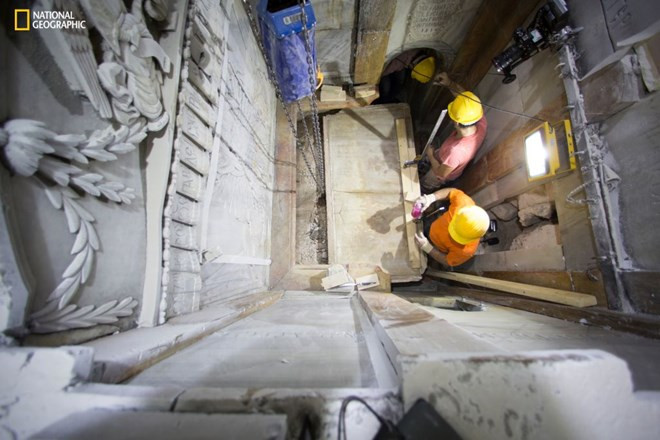Discover the stone bed Jesus Christ lay when he was buried
Conservation workers at the Holy Sepulcher Church in Jerusalem claim they have discovered a limestone bed that Jesus was laid on to be buried.
National Geographic magazine has published an article about this concussion detection. National Geographic also collaborated with a group of experts working at the church, considered the holiest place for Christians, because it was the place where Jesus was crucified and buried.

Expert group working at the Holy Church.(Source: AP).
The restoration work at the church has been carried out since the spring. However, last week, scientists from Athens National Technical University led a group of dozens of workers who were allowed to conduct 60-hour excavations in the place where the tomb was supposed to be buried.
They have moved the marble slab on the catacombs for centuries and worked tirelessly to find out what's on the bottom.
"When the marble slab was relocated on the night of October 26, the original survey showed only a layer of coating material below. However, when scientists continued their work within the next 60 hours, According to one, another marble slab with a crucifix carved above was discovered, and on the evening of October 28, just hours before the crypt was sealed again, the limestone bed was found. see intact, " National Geographic said.
Martin Biddle, an expert on the history of the crypt, said scholars will need to carefully study the collected data when discovering the bed and cave walls to establish a connection. officially to Jesus.
"The surface of the slab needs to be carefully researched to find traces of decorative drawings , " Biddle shared with National Geographic. "Why does bishop Eusebius, the 4th century historian, define this tomb as the tomb of God? He did not say the reason and we do not know either. I personally think Eusebius is not wrong - he is a wise scholar - so perhaps the evidence will appear if someone searches for them. "
Archaeologists from Greece say they have obtained a lot of excavation materials and will definitely conduct a thorough examination of what they have collected. They came to this sanctuary last week as part of a restoration project and preserved the small 18th-century architecture, including this ancient tomb.
Historians have long believed that the original ruins of the crypt were destroyed after hundreds of years. The original church on the site of Jesus' burial was destroyed in 1009, almost a century before the first Crusade was conducted in 1099.

Stone slabs that the expert team found.(Source: Times of Israel).
The Fatimid Islamic State in Egypt then ordered the government at Ramle to destroy the church, and a Christian story from Antioch that wrote that the Arabs "sought to erase the Holy Church, causing all traces to disappear or be destroyed ".
However, what archaeologists find surprising is that the remnants of the tunnel remain unaffected.
The Associated Press reported that after relocating the top marble slab on Friday, archaeologists found a second, gray stone with a cross carved above, thought to be after the 12th century. After relocating this gray marble slab, they found part of the cave wall.
"This is a sacred stone that has been worshiped for centuries, but has only been seen to date," said Antonia Moropoulou, head of the conservation and restoration department of the project.
"I feel so great. My knees are slightly trembling because I don't expect this to happen," said Fredric Hiebert, a permanent archaeologist of National Geographic.
"Not 100% sure yet, but it seems that this is clear evidence that the tomb's position has never changed - which has caused scientists and historians to wonder for decades".

Entrance to the Holy Church(Source: Times of Israel).
National Geographic also noted that although it is not certain that this tomb is a burial place for Jesus, the discovery of at least six other stone tombs around the church shows that this place is a Jewish cemetery in the second half. the second Temple period - the time when Jesus used to live.
Dan Bahat, a former archaeologist of Jerusalem, said: "We are not quite sure that the Holy Church is a place to bury Jesus, but we are sure there is no other place to offer a degree. The evidence is so heavy and we really have no reason to doubt the authenticity of this place. "
The restoration team installed a window to observe a part of the area where scientists have excavated it to help visitors see this limestone cave.
- The search for the living descendant of Jesus
- Tomb of Jesus is about to open
- Revealing the true face of Jesus
- The mystery of the healing ability of the towel that wipes Jesus' face
- Controversy around the real life role of Jesus
- Admire the true content of Jesus
- 1,500-year-old stone mosaic buried in ash
- Restoring the face of a woman who was supposed to be the wife of Jesus
- Jesus Christ appeared in the image of a baby girl soon to be born
- Found the place where Jesus might be a child
- Finding a rare face painting Jesus is more than 1,500 years old
- Discover the oldest lizard lord
 Discovered an ancient centipede fossil 99 million years old
Discovered an ancient centipede fossil 99 million years old Discovered bat-like dinosaurs in China
Discovered bat-like dinosaurs in China Discovered a 200-year-old bronze cannon of the coast
Discovered a 200-year-old bronze cannon of the coast Discover 305 million-year-old spider fossils
Discover 305 million-year-old spider fossils